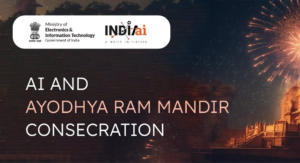The consecration of the Ram Mandir in Ayodhya on January 22 has sparked religious fervor and intense preparations. The Department of Telecommunications (DoT) is utilizing Artificial Intelligence (AI) to ensure uninterrupted connectivity for the expected attendees, marking a significant step in leveraging technology for enhanced security and crowd management.
The Uttar Pradesh government is leaving no stone unturned to ensure the safety and protection of the temple town during this significant event. With the anticipation of a large gathering, including saints and high-profile dignitaries, security measures have been heightened, incorporating AI-driven surveillance and monitoring systems.
To address potential security threats, AI surveillance has been deployed in Ayodhya, featuring the use of AI-powered drones for aerial monitoring and specialized drones designed to detect explosives or mines in underground areas. Staqu Technologies, an AI firm based in Gurgaon, plans to contribute to security measures using its advanced AI-powered audio and video analytics platform, Jarvis. The platform employs facial and number plate recognition to actively monitor the event for potential threats, notifying authorities in real-time.

Jarvis also supports reverse facial recognition, allowing authorities to identify individuals of interest based on provided images. Equipped with Automatic Number Plate Recognition (ANPR) capabilities, the surveillance cameras can cross-reference vehicle registration databases, aiding in the detection of vehicles with counterfeit license plates.
The AI-integrated cameras, part of the security infrastructure, enable attribute-based searches, such as identifying individuals based on specific attire, colors, accessories, or the presence of a child. The technology extends beyond human recognition, with the ability to identify cars based on their distinctive signatures.
Prashant Kumar, the Director General of Law and Order, announced a pilot project leveraging artificial intelligence for enhanced security in Ayodhya. The AI-powered closed-circuit television (CCTV) monitoring system, utilizing Jarvis, is designed to identify regular visitors and detect recurring patterns among groups of individuals visiting the temple.
The implementation of AI technologies for security and crowd management is not unique to Ayodhya. The Mahakal Lok Corridor in Ujjain, Madhya Pradesh, has implemented face recognition technology (FRT) and AI analytics to manage crowds effectively. FRT creates a unique profile ID based on an individual’s facial features upon entering the temple complex, allowing accurate monitoring of the number of visitors and their movements within Mahakal Lok.
Earlier instances of leveraging AI for religious institutions include the trial implementation of facial recognition technology by Tirumala Tirupati Devasthanams (TTD), managing the Tirupati temple in Andhra Pradesh. This technology was employed in booking accommodations and facilitating seamless admission for devotees, showcasing the potential of AI in enhancing the overall experience and security in religious settings.
The use of AI in securing and managing religious events reflects a growing trend in adopting technology to address unique challenges and ensure the safety and satisfaction of attendees. As the consecration of the Ram Mandir approaches, the integration of AI demonstrates a proactive approach to security and crowd management, setting a precedent for leveraging technology in religious ceremonies and events.






